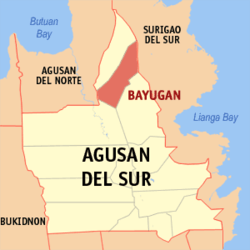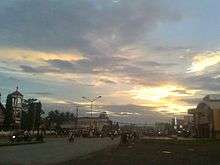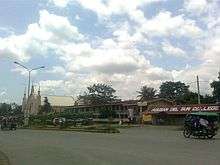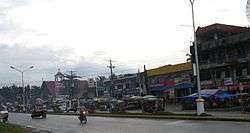Bayugan
| Bayugan | ||
|---|---|---|
| Component City | ||
| City of Bayugan | ||
|
Bayugan City center | ||
| ||
| Nickname(s): City of Rice Corn and Flowers; Cut Flower Capital of Agusan del Sur; Agusan del Sur Growth Center; Timberland City; Rice Capital of Agusan del Sur; Heart of Caraga | ||
 Map of Agusan del Sur with Bayugan highlighted | ||
.svg.png) Bayugan Location within the Philippines | ||
| Coordinates: 8°43′N 125°45′E / 8.71°N 125.75°ECoordinates: 8°43′N 125°45′E / 8.71°N 125.75°E | ||
| Country | Philippines | |
| Region | Caraga (Region XIII) | |
| Province | Agusan del Sur | |
| District | 1st District of Agusan del Sur | |
| Founded | August 20, 1961 | |
| Barangays | 43 | |
| Government[1] | ||
| • Mayor | Kim Lope Asis (NUP) | |
| • Vice Mayor | Charles Anggayong (NUP) | |
| Area[2] | ||
| • Total | 688.77 km2 (265.94 sq mi) | |
| Population (2015 census)[3] | ||
| • Total | 103,202 | |
| • Density | 150/km2 (390/sq mi) | |
| Demonym(s) | Bayuganon | |
| Time zone | PHT (UTC+8) | |
| ZIP code | 8502 | |
| Dialing code | 85 | |
| Income class | 5th class | |
| Website |
www | |
Bayugan is a city in the province of Agusan del Sur, Philippines. It has a population of 103,202 according to the 2015 census.[3] The city is classified as a fifth class city according to Philippine Statistics Authority (Republic Act No. 7160). Being the only city in the 1st Congressional District and the only city in the province of Agusan del Sur, Bayugan serves as the growth center of the province.
Located at the northern part of Agusan del Sur, Bayugan is the "cut-flower capital" of the province owing to its lucrative cut flower industry. The city's climate, especially in the highland barangays, is conducive to high yield cut-flower production. The city is also one of the major producers of rice and vegetables in the province, even providing the needs of neighboring municipalities and provinces.
Etymology
The name "Bayugan" is a Manobo term for pathway, since then the natives called the place, Bayugan. Another version states that "bayug" trees grew abundantly in this place. It was also believed that the natives used to make this place their meeting spot and that the means of gathering the inhabitants was by knocking on a hollow piece of wood which they termed as the "bayug."
History
Bayugan was formerly a sitio of Barangay Maygatasan, Esperanza. Several versions abound on how the sitio got its name. First, the place was located along the river which served as the pathway of the natives in going to Esperanza.
In 1942, Japanese troops entered Bayugan.
In 1945, the town of Bayugan in Southern Agusan was liberated by Filipino soldiers and guerrillas from the Japanese forces occupying the town.
In 1948, the Department of Public Works and Highways conducted a survey for a national highway that would connect Butuan with Davao City. Simultaneously, the Bureau of Lands surveyed the places that would be traversed by the proposed road. Possible town sites were identified and among them was Barangay Maygatasan. However, the National highway passed through the sitio of Bayugan instead of Barangay Maygatasan. Migrants started settling in the sitio of Bayugan, thus, prompting the transfer of the proposed town site.
In the early part of 1960, the inhabitants led by Mr. Jose Joson passed a resolution creating the sitio of Bayugan into a regular barrio. In April of that year, Barangay Bayugan was inaugurated with Joson as the Teniente del Barrio. Brought about by the construction of the National Highway which traversed the place, business activity sprouted rapidly in the area.
A year later, barangay officials led by the late Sergio Mullaneda worked out the creation of Bayugan into a regular municipality through the assistance of Governor Democrito O. Plaza, Governor of Agusan. By virtue of Executive Order No. 440 of the late President Carlos P. Garcia, the petition to create the municipality of Bayugan was granted on August 6, 1961. Mr. Mullaneda, the first appointed Municipal Mayor of Bayugan assumed into office on August 6, 1962 during the term of President Diosdado Macapagal. In the year 2007 Bayugan was converted to a city.
Bayugan is a transportation highway nexus for the eastern part of Mindanao Island. Bayugan is now one if not the fastest growing component city in Northern Mindanao.
Cityhood

-
During the 11th Congress (1998–2001), Congress enacted into law 33 bills converting 33 municipalities into cities. However, Congress did not act on a further 24 bills converting 24 other municipalities into cities.
During the 12th Congress (2001–2004), Congress enacted into law Republic Act No. 9009 (RA 9009), which took effect on 30 June 2001. RA 9009 amended Section 450 of the Local Government Code by increasing the annual income requirement for conversion of a municipality into a city from ₱20 million to ₱100 million. The rationale for the amendment was to restrain, in the words of Senator Aquilino Pimentel, "the mad rush" of municipalities to convert into cities solely to secure a larger share in the Internal Revenue Allotment despite the fact that they are incapable of fiscal independence.
After RA 9009 went into effect, the House of Representatives of the 12th Congress adopted Joint Resolution No. 29, which sought to exempt from the ₱100 million income requirement in RA 9009 the 24 municipalities whose cityhood bills were not approved in the 11th Congress. However, the 12th Congress ended without the Senate having approved Joint Resolution No. 29.
During the 13th Congress (2004–2007), the House of Representatives re-adopted former Joint Resolution No. 29 as Joint Resolution No. 1 and forwarded it to the Senate for approval. However, the Senate again failed to approve the Joint Resolution. Following the suggestion of Senator Aquilino Pimentel (Senate President), 16 municipalities filed, through their respective sponsors, individual cityhood bills. The 16 cityhood bills each contained a common provision exempting it from the ₱100 million income requirement of RA 9009 –
"Exemption from Republic Act No. 9009. — The City of x x x shall be exempted from the income requirement prescribed under Republic Act No. 9009."
On 22 December 2006, the House of Representatives approved the cityhood bills. The Senate also approved the cityhood bills in February 2007, except that of Naga, Cebu which was passed on 7 June 2007. These cityhood bills lapsed into law on various dates from March to July 2007 after President Gloria Macapagal-Arroyo failed to sign them.
The point of law at issue in 2007 was whether there had been a breach of Section 10, Article X of the 1987 Constitution, which provides –
No province, city, municipality, or barangay shall be created, divided, merged, abolished or its boundary substantially altered, except in accordance with the criteria established in the local government code and subject to approval by a majority of the votes cast in a plebiscite in the political units directly affected.
– and in each case the established criteria were far from met.
In November 2008, Bayugan and 15 other cities lost their cityhood after the Supreme Court of the Philippines granted a petition filed by the League of Cities of the Philippines, and declared unconstitutional the cityhood law (RA 9405) which had allowed the town to acquire its city status.[4] The Supreme Court ruled that they did not pass the requirements for cityhood.[5][6]
On 10 December 2008, the 16 cities affected acting together filed a motion for reconsideration with the Supreme Court. More than a year later, on 22 December 2009, acting on said appeal, the Court reversed its earlier ruling as it ruled that "at the end of the day, the passage of the amendatory law" (regarding the criteria for cityhood as set by Congress) "is no different from the enactment of a law, i.e., the cityhood laws specifically exempting a particular political subdivision from the criteria earlier mentioned. Congress, in enacting the exempting law/s, effectively decreased the already codified indicators."[7] Accordingly cityhood status was restored.
But on 27 August 2010, the 16 cities lost their city status again, after the Supreme Court voted 7-6, with two justices not taking part, to reinstate the 2008 decision declaring as "unconstitutional" the Republic Acts that converted the 16 municipalities into cities. A previous law required towns aspiring to become cities to earn at least ₱100 million annually, which none of the 16 did.[8]
On 15 February 2011, the Supreme Court made another volte-face and upheld for the third time the cityhood of 16 towns in the Philippines.[9]
Finally, on 12 April 2011, the Supreme Court, in an en banc ruling delivered in Baguio City, affirmed the finality of the constitutionality of the 16 cityhood laws by resolving that:
We should not ever lose sight of the fact that the 16 cities covered by the Cityhood Laws not only had conversion bills pending during the 11th Congress, but have also complied with the requirements of the LGC prescribed prior to its amendment by R.A. No. 9009.[8] Congress undeniably gave these cities all the considerations that justice and fair play demanded. Hence, this Court should do no less by stamping its imprimatur to the clear and unmistakable legislative intent and by duly recognizing the certain collective wisdom of Congress. WHEREFORE, the Ad Cautelam Motion for Reconsideration (of the Decision dated 15 February 2011) is denied with finality.[9]
On 28 June 2011 the Supreme Court directed the Clerk of Court to issue the entry of judgment on the cityhood case of 16 municipalities.[10] This entry of judgment ended the cityhood battle of the 16 cities.
On July 24, 2006, congress approved R.A. 9405, an act converting the Municipality of Bayugan into a component city to be known as the City of Bayugan.
But in 2008, the Supreme Court of the Philippines declared the law unconstitutional. The court ruled that Bayugan, along with the other fifteen cities covered by the law did not meet the requirements for cityhood.
More than a year later, on December 22, 2009, acting favorably on the appeal of the sixteen affected cities, the Supreme Court reversed its earlier ruling. It deemed that the passage of the amendatory law regarding the criteria for cityhood as set by Congress specifically exempting a particular political subdivision therefrom was constitutional. The court further ruled that congress, in enacting the exempting law, effectively decreased the already codified indicators. As such, the cityhood status of Bayugan, and the rest of the fifteen local government units was restored.
But again on August 24, 2010, in a 16-page resolution, the Supreme Court reinstated its November 18, 2008 decision striking down the constitutionality of Republic Act 9405. Voting 7-6, with two justices abstaining, the SC reinstated its decision declaring RA 9405 as unconstitutional.
However, in another twist of fate for Bayugan, the Supreme Court once again upheld for the 3rd time and final time the constitutionality of RA 9405 on February 17, 2011, thereby finalizing the cityhood of Bayugan and the other fifteen LGUs affected by the law. On July 3, 2011, the Supreme Court ordered its Clerk of Court to issue an entry of judgment on the cityhood case, sealing with finality the constitutionality of the law. [11]
Geography
Bayugan is bordered by the Municipality of Sibagat and the province of Surigao del Sur to the north; the Municipality of Prosperidad to the east; the Municipality of Esperanza to the south; and the Municipality of Las Nieves, Agusan del Norte, to the west.
Climate
The city is geographically situated below the typhoon belt but is usually affected by depressions forming in the typhoon regions of Visayas and the province of Surigao del Norte. The climate map of the Philippines based on the modified coronas classification shows that the city falls under Type II. Which also is the weather classification of the province of Agusan del Sur.
Type II climate has no dry season with very pronounced wet season of heavy precipitation. Maximum rainfall generally occurs from December to January although there is no single dry month. Its average monthly rainfall is 161.6 millimetres (6.36 in) and average temperature is 32 °C (90 °F). Areas characterized by this climate type are generally along or very near the eastern coast thus are open to the north-east monsoon.
| Climate data for Bayugan City, Philippines | |||||||||||||
|---|---|---|---|---|---|---|---|---|---|---|---|---|---|
| Month | Jan | Feb | Mar | Apr | May | Jun | Jul | Aug | Sep | Oct | Nov | Dec | Year |
| Average high °C (°F) | 30 (86) |
31 (88) |
31 (88) |
33 (91) |
33 (91) |
33 (91) |
32 (90) |
33 (91) |
33 (91) |
32 (90) |
32 (90) |
31 (88) |
32 (90) |
| Average low °C (°F) | 23 (73) |
23 (73) |
23 (73) |
24 (75) |
25 (77) |
24 (75) |
24 (75) |
24 (75) |
24 (75) |
24 (75) |
24 (75) |
24 (75) |
24 (75) |
| Average precipitation mm (inches) | 259.1 (10.201) |
236.7 (9.319) |
131.5 (5.177) |
102.6 (4.039) |
104.9 (4.13) |
155.8 (6.134) |
146.4 (5.764) |
103.6 (4.079) |
123.1 (4.846) |
166.8 (6.567) |
166.5 (6.555) |
242.7 (9.555) |
1,939.7 (76.366) |
| Average precipitation days | 22 | 19 | 18 | 13 | 15 | 20 | 18 | 16 | 16 | 19 | 21 | 24 | 221 |
| Source: World Weather Online | |||||||||||||
Barangays
Bayugan is politically subdivided into 43 barangays, of which 3 are urban and 40 are rural. (Population is according to the 2010 Census of Population and Housing)[2][12]
- Berseba (1,688)
- Bucac (3,367)
- Cagbas (1,575)
- Calaitan (2,385)
- Canayugan (1,167)
- Charito (1,529)
- Claro Cortez (654)
- Fili (2,923)
- Gamao (1,035)
- Getsemane (436)
- Grace Estate (651)
- Hamogaway (1,568)
- Katipunan (1,135)
- Mabuhay (1,750)
- Magkiangkang (1,628)
- Mahayag (554)
- Marcelina (3,508)
- Maygatasan (4,148)
- Montivesta (602)
- Mt. Ararat (821)
- Mt. Carmel (2,047)
- Mt. Olive (1,501)
- New Salem (663)
- Noli (3,380)
- Osmeña (1,573)
- Panaytay (624)
- Pinagalaan (1,108)
- Poblacion (city center) (17,596)
- Sagmone (1,157)
- Saguma (1,937)
- Salvacion (5,079)
- San Agustin (613)
- San Isidro (1,046)
- San Juan (3,391)
- Santa Irene (2,820)
- Santa Teresita (1,168)
- Santo Niño (1,643)
- Taglatawan (commercial center) (12,976)
- Taglibas (386)
- Tagubay (749)
- Verdu (1,373)
- Villa Ondayon (1,312)
- Wawa (Del Carmen) (1,413)
Demographics
| Population census of Bayugan | ||
|---|---|---|
| Year | Pop. | ±% p.a. |
| 1990 | 78,725 | — |
| 1995 | 89,999 | +2.54% |
| 2000 | 93,623 | +0.85% |
| 2007 | 95,032 | +0.21% |
| 2010 | 99,361 | +1.63% |
| 2015 | 103,202 | +0.72% |
| Source: National Statistics Office[3][12][13] | ||
Indigenous people:
- Manobo
- Higaonon
- Banwaon
- Kamayo/Mandaya
- Talandig
Economy
Products:
- Rice / palay (the major rice production site of Agusan del Sur)
- Cut Flowers (abundant in the city making it the cut flower capital of Agusan del Sur)
- Corn
- Coconut
- Banana
- Rubber
- Vegetables
- Legumes
- Cacao
- Coffee
- Citrus
- Root Crops
- Fruits
Fertile soil suitable for agricultural, Protection Forest About 26,107.163 Hectares = 51.697% in land classifications. Gold, silver, sand and gravel.
Places of interest

- Bayugan Rotunda – Bayugan's most prominent landmark simply the widest circular park in Mindanao
- Rizal Park Plaza – largest park in the province
- Narra Avenue – the widest road in the province. The Avenue serves as the main road of the city and is a six lane road. At night, Narra Avenue is the brightest and most lit road in the province.
- Bayug (Hamogaway) Falls – located at Brgy Hamogaway, the falls is now known to be a tourist attraction in the city.
- Pinagalaan Falls – the biggest and tallest falls in the city.
- Gethsemane Falls
- Wawa River and Irrigation System
- Wawa Bridge - largest steel bridge in the province. The bridge serves as the road boundary of Bayugan City and Sibagat, Agusan del Sur.
- Family Place Resort
- Green Haven Adventure Park
- Mangrove Base Park
- Bayugan City Hall
- ARC Bayugan
- Graceland Cold Spring
- Magkiangkang Cave – a spectacular cave located at the mountainous barangay of Magkiankang.
- New Loon Cave
- San Agustin Lake
- Putting Bato Cave
- Katipunan Lake
- Vising/Sisimon Cave
- Sacred of Jesus Parish Church
- San Lorenzo Ruiz Diocesan Shrine
Local festivals, and events

- Kahimunan Festival, Holy Child – a local version of the Sinulog Festival of Cebu, it is highlighted by street dancing focusing on the indigenous tribes' of Bayugan and their way of life. Celebrated every Last Sunday of January.
- Sacred Heart of Jesus Festival – popularly known as the town fiesta or "pista", celebrated every 30 June.
- Rice Corn and Flower Festival – a new born festival replacing the traditional "Araw ng Bayugan". The festival is named from the nickname of the city (City of Rice, Corn, and Flowers). It highlights street dancing and float contests.
- Charter Day Celebration- held every 21 June to commemorate the city-hood of Bayugan.
Transportation

Land
Bayugan can be reached via land transport. Bachelor Express, Land Car Inc., Surigao Express are only few bus companies travelling to and from the city. Major transportation are motorela and some multicabs which travel to remote barangays. "Habal-habal" is also used as a transport to the mountain barangays of Bayugan.
Air and sea
Butuan has the nearest sea and air ports from Bayugan. Other air and sea ports are located at Davao City and Surigao City.
Local government
City officials
Elected city officials 2013-2016:
Executive:
- Mayor: Kim Lope A. Asis
- Vice Mayor: Charles P. Anggayong
Legislative:
- City councilors:
- Kirk A. Asis (ABC Liga ng mga Barangay President)
- Fortunato A. Paway
- Charles C. Salazar
- Jeremais A. Estuya
- Edgardo D. Hinlo
- Pedro M. Alonde
- Ferdinand H. Ebarle
- Gilbert M. Honculada
- Orlando A. Sevilla Sr.
- Allan R. Cogollodo
Barangay council
Association of Baragay Councils (Liga ng mga Barangay):
- President - Kirk A. Asis (Brgy. Poblacion)
- Vice President - Vacant position
Education
Bayugan National Comprehensive High School, or BNCHS, is a comprehensive high school with a population of exactly 5,365 students, and is located on a site that has an area of 5 hectares. The school is currently recognized for its research program in science related topics. "Comprehensive" it is because it offers different curricula such as ESEP (Engineering and Science Education Program) on its 1st Year, Project BEST (Breeding Excellence in Science and Technology), Special Program in Journalism (pilot school for journalism in CARAGA Region), Special Program in the Arts (with the specialization of Visual Arts, Creative Writing, Dancing, Music, Media Arts and Theater Arts), Technical Vocational Courses, Special Program in Sports and Revised Basic Education Curriculum. The school is currently headed by the Secondary School Principal IV, Dr. Wilson C. Calvo.

Agusan del Sur College or ADSCO established in 1966, is the only private educational institution in the city offering Preparatory, Elementary, High School, College (CHED) degree courses i.e. Bachelor of Science in Business Administration (BSBA) major in : Marketing Management, Financial Management, Operation Management, Bachelor of Secondary Education, Bachelor of Elementary Education, Bachelor of Arts major in English, Associate in Computer Secretarial, Bachelor of Science in Hotel and Restaurant Management (by year 2011) and TESDA programs like Health Care Services NC II, Computer Hardware Servicing NC II, Shielded Metal Arc Welding (SMAW) NC II, Driving NC II, Security Services NC II, Massage Therapy NC II, Housekeeping, Commercial Cooking NC II, Bookkeeping NC II.
Father Saturnino Urios College of Bayugan Inc. (formerly Father Urios Technical Institute of Bayugan Inc. or FUTIBI), is the oldest private educational institution in the city. Located at the heart of the city making it one of the most populous school in Bayugan. Created in the year 1959, Urios caters elementary and secondary basic education. By school year 2010–2011, Urios will be putting up its technical courses.The school was founded by a Jesuit priest Father Atanasio B. De Castro in 1959. The school is currently headed by Dr. Pelagia Joven (Principal) and Fr. Roberto Butawan (School Director).
Sister cities
Gallery
-
Kim Lope A. Asis Memorial Gymnasium along Narra Avenue.
-
Panorama of Rotunda Park.
-
Aerial view of Bayugan City Rotunda.
-
Sunset in Bayugan City.
References
- ↑ "Official City/Municipal 2013 Election Results". Intramuros, Manila, Philippines: Commission on Elections (COMELEC). 11 September 2013. Retrieved 10 April 2014.
- 1 2 "Province: AGUSAN DEL SUR". PSGC Interactive. Makati City, Philippines: National Statistical Coordination Board. Retrieved 10 April 2014.
- 1 2 3 "CARAGA". Census of Population (2015): Total Population by Province, City, Municipality and Barangay (Report). PSA. Retrieved 20 June 2016.
- ↑ Republic Act No. 9405 of 23 March 2007 Charter of the City of Bayugan
- ↑ G.R. No. 176951 et al. (First appeal) of 18 November 2008 Consolidated petitions for prohibition assailing the constitutionality of the subject Cityhood Laws and enjoining the Commission on Elections (COMELEC) and respondent municipalities from conducting plebiscites pursuant to the Cityhood Laws.
- ↑ Napallacan, Jhunex (2008-11-21). "Cities' demotion worries DepEd execs". Cebu Daily News. Inquirer.net. Retrieved 15 February 2015.
- ↑ G.R. No. 176951 et al. (First reversal) of 21 December 2009
- 1 2 Republic Act No. 9009 of 24 February 2001 An Act amending section 450 of Republic Act no. 7160, otherwise known as the Local Government Code of 1991, by increasing the average annual income requirement for a municipality or cluster of barangays to be converted into a component city.
- 1 2 G.R. No. 176951 et al. (Second appeal) of 15 February 2011 League of Cities of the Philippines v. COMELEC
- ↑ G.R. No. 176951 et al. (Final Resolution) of 28 June 2011 Supreme Court has directed the Clerk of Court to forthwith issue the Entry of Judgment
- ↑ Republic Act 9405
- 1 2 "Total Population by Province, City, Municipality and Barangay: as of May 1, 2010" (PDF). 2010 Census of Population and Housing. National Statistics Office. Archived from the original (PDF) on 26 June 2013. Retrieved 10 April 2014.
- ↑ "Province of Agusan Del Sur". Municipality Population Data. LWUA Research Division. Retrieved 10 April 2014.
External links
| Wikimedia Commons has media related to Bayugan. |
- Philippine Standard Geographic Code
- A History of Bayugan at the Agusan–Surigao Historical Archive
- http://www.sunstar.com.ph/manila/local-news/2011/07/03/sc-16-cityhood-laws-constitutional-final-164696
- Municipality of Bayugan Official Website
- https://web.archive.org/web/20120327162332/http://www.pueblophilippines.com/philippine-cities-financial-profile-200-income-and-expenses
- http://www.newsbayugan.com/
 |
Sibagat | Lanuza, Surigao del Sur Tandag, Surigao del Sur |
 | |
| Sibagat Butuan City |
|
San Miguel, Surigao del Sur | ||
| ||||
| | ||||
| Las Nieves, Agusan del Norte | Esperanza | Prosperidad |


